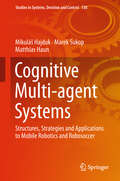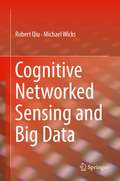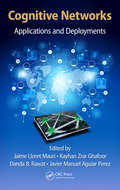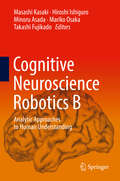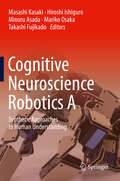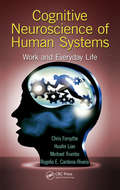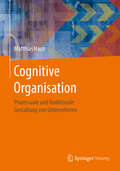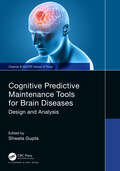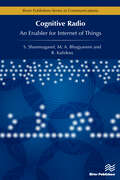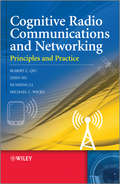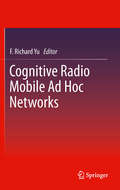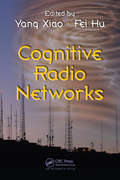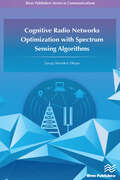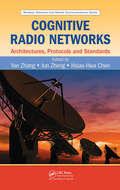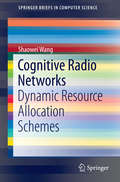- Table View
- List View
Cognitive Multi-agent Systems: Structures, Strategies and Applications to Mobile Robotics and Robosoccer (Studies in Systems, Decision and Control #138)
by Matthias Haun Mikuláš Hajduk Marek SukopThe book describes an approach to the multi-agent systems (MAS) design for applications of robotic soccer in the MiroSot category. The described MAS is designed for dynamic, quickly changing environments, in which not only the actions of our MAS are observed, but also those of the opposing MAS. It actively tries to affect the environment to score goals faster than the opposing MAS. Multi-agent systems (MAS) are mostly applied in the environments in which they exist and act without an opposing system. The book also describes strategies based on a supervisor that makes decisions depending on behavior prediction of the opposing MAS and the ball movement in the working place. A sophisticated distribution of tasks was designed for each agent to cooperate in order score goals as fast as possible. Simultaneously, these agents try, by permitted means, to prevent the enemy agents from scoring goals. The approach described is an excellent guide to the constantly evolving abilities of mobile robotics, both for real-world applications, such as cooperation of multiple robots in life-saving activities, and for the steadily developing applications of mobile robots in various robotic competitions (e.g. Robocup, etc.). The book provides readers with high-level knowledge on how to design strategies and how to implement such systems, and the ideas presented enable them to further refine the approach utilizing the latest hardware and use it in new systems implementations of sophisticated intelligent engineering.
Cognitive Networked Sensing and Big Data
by Michael Wicks Robert QiuWireless Distributed Computing and Cognitive Sensing defines high-dimensional data processing in the context of wireless distributed computing and cognitive sensing. This book presents the challenges that are unique to this area such as synchronization caused by the high mobility of the nodes. The author will discuss the integration of software defined radio implementation and testbed development. The book will also bridge new research results and contextual reviews. Also the author provides an examination of large cognitive radio network; hardware testbed; distributed sensing; and distributed computing.
Cognitive Networks: Applications and Deployments
by Danda B. Rawat Jaime Lloret Mauri Kayhan Zrar Ghafoor Javier Manuel Aguiar PerezA cognitive network makes use of the information gathered from the network in order to sense the environment, plan actions according to the input, and make appropriate decisions using a reasoning engine. The ability of cognitive networks to learn from the past and use that knowledge to improve future decisions makes them a key area of interest for
Cognitive Neuroscience Robotics A: Analytic Approaches to Human Understanding
by Masashi Kasaki Hiroshi Ishiguro Minoru Asada Mariko Osaka Takashi FujikadoCognitive Neuroscience Robotics is the first introductory book on this new interdisciplinary area. This book consists of two volumes, the first of which, Synthetic Approaches to Human Understanding, advances human understanding from a robotics or engineering point of view. The second, Analytic Approaches to Human Understanding, addresses related subjects in cognitive science and neuroscience. These two volumes are intended to complement each other in order to more comprehensively investigate human cognitive functions, to develop human-friendly information and robot technology (IRT) systems, and to understand what kind of beings we humans are. Volume A describes how human cognitive functions can be replicated in artificial systems such as robots, and investigates how artificial systems could acquire intelligent behaviors through interaction with others and their environment.
Cognitive Neuroscience Robotics A: Synthetic Approaches to Human Understanding
by Masashi Kasaki Hiroshi Ishiguro Minoru Asada Mariko Osaka Takashi FujikadoCognitive Neuroscience Robotics is the first introductory book on this new interdisciplinary area. This book consists of two volumes, the first of which, Synthetic Approaches to Human Understanding, advances human understanding from a robotics or engineering point of view. The second, Analytic Approaches to Human Understanding, addresses related subjects in cognitive science and neuroscience. These two volumes are intended to complement each other in order to more comprehensively investigate human cognitive functions, to develop human-friendly information and robot technology (IRT) systems, and to understand what kind of beings we humans are. Volume A describes how human cognitive functions can be replicated in artificial systems such as robots, and investigates how artificial systems could acquire intelligent behaviors through interaction with others and their environment.
Cognitive Neuroscience of Human Systems: Work and Everyday Life (Human Factors and Ergonomics)
by Rogelio E. Cardona-Rivera Chris Forsythe Huafei Liao Michael Christopher TrumboWhile there have been tremendous advances in our scientific understanding of the brain, this work has been largely academic, and often oriented toward clinical publication. Cognitive Neuroscience of Human Systems: Work and Everyday Life addresses the relationship between neurophysiological processes and the performance and experience of humans in e
Cognitive Organisation: Prozessuale und funktionale Gestaltung von Unternehmen
by Matthias HaunDie in dem Buch beschriebenen Methoden und Techniken sichern Unternehmen den Entwicklungsvorsprung, der ben#65533;tigt wird, um mit hoher Innovations- und Zukunftssicherheit in organisatorischer und technologischer Hinsicht auf dynamischen M#65533;rkten zu bestehen. Der innovative Ansatz stellt die Begriffe Kognition, Organisation, Wissen und Technologie in den Mittelpunkt. Mit Hilfe der wissensbasierten, handlungsorientierten und simulationsvalidierten Methodik k#65533;nnen innovative Unternehmen als kognitive, wandelbare Organisationen entwickelt werden.
Cognitive Predictive Maintenance Tools for Brain Diseases: Design and Analysis (Chapman & Hall/CRC Internet of Things)
by Shweta GuptaThis book involves the design, analysis, and application of various cognitive predictive maintenance tests with the help of tools like vibration analysis, ultrasonic analysis, infrared analysis, oil analysis, laser-shaft alignment, and motor circuit analysis in the prediction of various cognitive diseases such as epilepsy, Parkinson’s disease, Alzheimer’s disease, and depression. These are needed since there are no proper medical tests available to predict these diseases in remote areas at an early stage. Various emerging technologies are analyzed for the design of tests. Key features: Incorporates innovative processes for treating cognitive diseases. Early and exact identification and treatment strategies are incorporated. Future technologies like artificial intelligence, machine learning, the IoT, and data science are used to find solutions. Analysis with existing cognitive disease solutions is incorporated and simulations provided. The novelty of the book lies in the accurate prediction of cognitive diseases. Encompassing future technologies and various communication protocols or devices available for cognitive diseases for the design of new equipment are an outcome of the book. Various parameters like power consumption, productivity, and safety should be taken into account during the analysis, design, and application of a product. The book could well be added to the curriculum of medical colleges and biomedical engineering students. Possible vendors include biomedical research centers like Biotechnika and the Indian Council of Medical Research (ICMR). It would be a breakthrough for biomedical companies to launch their new products.
Cognitive Radio - An Enabler for Internet of Things (River Publishers Series In Communications Ser.)
by M. A. Bhagyaveni R. Kalidoss K. S. VishvaksenanInternet of Things (IoT) deals with the interconnection of devices that can communicate with each other over the internet. Currently, several smart systems have evolved with the evolution in IoT. Cognitive Radio - an enabler for Internet of Things is a research level subject for all communication engineering students at undergraduate, post graduate and research levels. The contents of the book are designed to cover the prescribed syllabus for one semester course on the subject prescribed by universities. Concepts have been explained thoroughly in simple and lucid language. Mathematical analysis has been used wherever necessary followed by clear and lucid explanation of the findings and their implication. Key technologies presented include dynamic spectrum access, spectrum sensing techniques, IEEE 802.22 and different radio network architectures. Their role and use in the context of mobile broadband access in general is explained, giving both a high level overview and a detailed step by step explanation. The book includes a large number of diagrams, MATLAB examples, thereby enabling the readers to have a sound grasp of the concepts presented and their applications. This book is a must have resource for engineers and other professionals in the telecommunication industry working with cellular or wireless broadband technologies, helping comprehension of the process of utilization of the updated technology to enable being ahead competition.
Cognitive Radio Communication and Networking
by Husheng Li Zhen Hu Michael C. Wicks Robert Caiming QiuThe author presents a unified treatment of this highly interdisciplinary topic to help define the notion of cognitive radio. The book begins with addressing issues such as the fundamental system concept and basic mathematical tools such as spectrum sensing and machine learning, before moving on to more advanced concepts and discussions about the future of cognitive radio. From the fundamentals in spectrum sensing to the applications of cognitive algorithms to radio communications, and discussion of radio platforms and testbeds to show the applicability of the theory to practice, the author aims to provide an introduction to a fast moving topic for students and researchers seeking to develop a thorough understanding of cognitive radio networks.Examines basic mathematical tools before moving on to more advanced concepts and discussions about the future of cognitive radioDescribe the fundamentals of cognitive radio, providing a step by step treatment of the topics to enable progressive learningIncludes questions, exercises and suggestions for extra reading at the end of each chapterCompanion website hosting MATLAB codes, and supplementary material including exercisesTopics covered in the book include: Spectrum Sensing: Basic Techniques; Cooperative Spectrum Sensing Wideband Spectrum Sensing; Agile Transmission Techniques: Orthogonal Frequency Division Multiplexing Multiple Input Multiple Output for Cognitive Radio; Convex Optimization for Cognitive Radio; Cognitive Core (I): Algorithms for Reasoning and Learning; Cognitive Core (II): Game Theory; Cognitive Radio Network IEEE 802.22: The First Cognitive Radio Wireless Regional Area Network Standard, and Radio Platforms and Testbeds.
Cognitive Radio Mobile Ad Hoc Networks
by F. Richard YuCognitive radios (CR) technology is capable of sensing its surrounding environment and adapting its internal states by making corresponding changes in certain operating parameters. CR is envisaged to solve the problems of the limited available spectrum and the inefficiency in the spectrum usage. CR has been considered in mobile ad hoc networks (MANETs), which enable wireless devices to dynamically establish networks without necessarily using a fixed infrastructure. The changing spectrum environment and the importance of protecting the transmission of the licensed users of the spectrum mainly differentiate classical MANETs from CR-MANETs. The cognitive capability and re-configurability of CR-MANETs have opened up several areas of research which have been explored extensively and continue to attract research and development. The book will describe CR-MANETs concepts, intrinsic properties and research challenges of CR-MANETs. Distributed spectrum management functionalities, such as spectrum sensing and sharing, will be presented. The design, optimization and performance evaluation of security issues and upper layers in CR-MANETs, such as transport and application layers, will be investigated.
Cognitive Radio Networks
by Ian MuehlenhausFueled by ongoing and increasing consumer demand, the explosive growth in spectrum-based communications continues to tax the finite resources of the available spectrum. One possible solution, Cognitive Radio Network (CRN), allows unlicensed users opportunistic access to licensed bands without interfering with existing users. Although some initial s
Cognitive Radio Networks Optimization with Spectrum Sensing Algorithms
by Tanuja S. DhopeIn recent years, a considerable amount of effort has been devoted, both in industry and academia, towards the efficient utilization of the available spectrum under the various propagation models which lead towards the design and dimensioning of the future network Internet of Things (IoT).This book focuses on Television White Space (TVWS) opportunities and regulatory aspects for cognitive radio applications, and includes case studies for the exploitation of TVWS depending on user's mobility, and the geo-location between user and the Base Station. The book presents recent advances in spectrum sensing, reflecting state of the art technology and research achievements in this area as well as a new insights in spectrum sensing of performance modeling, analysis and worldwide applications. Technical topics discussed include: • Novel Application of TV White Space• Spectrum Sensing in Cognitive Radio• Cooperative Spectrum Sensing• DoA Estimation Algorithms
Cognitive Radio Networks: Architectures, Protocols, and Standards
by Yan Zhang Jun Zheng Hsiao-Hwa ChenWhile still in the early stages of research and development, cognitive radio is a highly promising communications paradigm with the ability to effectively address the spectrum insufficiency problem. Written by those pioneering the field, Cognitive Radio Networks: Architectures, Protocols, and Standards offers a complete view of cognitive radio-incl
Cognitive Radio Networks: Dynamic Resource Allocation Schemes (SpringerBriefs in Computer Science)
by Shaowei WangThis SpringerBrief presents a survey of dynamic resource allocation schemes in Cognitive Radio (CR) Systems, focusing on the spectral-efficiency and energy-efficiency in wireless networks. It also introduces a variety of dynamic resource allocation schemes for CR networks and provides a concise introduction of the landscape of CR technology. The author covers in detail the dynamic resource allocation problem for the motivations and challenges in CR systems. The Spectral- and Energy-Efficient resource allocation schemes are comprehensively investigated, including new insights into the trade-offs for operating strategies. Promising research directions on dynamic resource management for CR and the applications in other wireless communication systems are also discussed. Cognitive Radio Networks: Dynamic Resource Allocation Schemes targets computer scientists and engineers working in wireless communications. Advanced-level students in computer science and electrical engineering will also find this brief useful reading about the next generation of wireless communication.
Cognitive Radio Networks: Efficient Resource Allocation in Cooperative Sensing, Cellular Communications, High-Speed Vehicles, and Smart Grid
by Tao Jiang Yang Cao Zhiqiang WangResource allocation is an important issue in wireless communication networks. In recent decades, cognitive radio-based networks have garnered increased attention and have been well studied to overcome the problem of spectrum scarcity in future wireless communication systems. Many new challenges in resource allocation appear in cognitive radio-based networks. This book focuses on effective resource allocation solutions in several important cognitive radio-based networks, including opportunistic spectrum access networks, cooperative sensing networks, cellular networks, high-speed vehicle networks, and smart grids.
Cognitive Radio Networks: From Theory to Practice (Analog Circuits and Signal Processing)
by Magdy Bayoumi Ahmed Khattab Dmitri PerkinsThis book describes a communication paradigm that could shape the future of wireless communication networks, Opportunistic Spectrum Access (OSA) in Cognitive Radio Networks (CRN). While several theoretical OSA approaches have been proposed, they are challenged by the practical limitations of cognitive radios: the key enabling technology of OSA. This book presents an unprecedented formulation of the OSA problem in CNR that takes into account the practical limitations encountered due to existing technologies. Based on such a problem formulation, this book presents a framework and protocol details implementing the analytically-optimized solution of this problem. Unlike the state-of-the-art of CRN implementations that typically target software define radios which are not suitable for real systems, this book describes the implementation of distributed OSA, using practical radio transceiver technologies. It provides a thorough characterization of the gains available to theoretical OSA approaches if the practical limitations are taken into consideration. Tackles the cognitive radio networks performance optimization problem, taking into account the practical limitations of today's technologies; Provides thorough performance evaluation in arbitrary, large-scale networks, as well as microscopic, small-scale performance evaluation, using realistic hardware implementation;Presents an empirical study of the gains available over existing techniques by adopting practical approaches; Tackles the cognitive radio networks performance optimization problem, taking into account the practical limitations of today's technologies; Provides thorough performance evaluation in arbitrary, large-scale networks, as well as microscopic, small-scale performance evaluation, using realistic hardware implementation;Presents an empirical study of the gains available over existing techniques by adopting practical approaches;
Cognitive Radio Networks: Medium Access Control for Coexistence of Wireless Systems
by Kaigui Bian Jung-Min Park Bo GaoThis book gives a comprehensive overview of the medium access control (MAC) principles in cognitive radio networks, with a specific focus on how such MAC principles enable different wireless systems to coexist in the same spectrum band and carry out spectrum sharing. From algorithm design to the latest developments in the standards and spectrum policy, readers will benefit from leading-edge knowledge of how cognitive radio systems coexist and share spectrum resources. Coverage includes cognitive radio rendezvous, spectrum sharing, channel allocation, coexistence in TV white space, and coexistence of heterogeneous wireless systems.
Cognitive Radio Oriented Wireless Networks: 11th International Conference, CROWNCOM 2016, Grenoble, France, May 30 - June 1, 2016, Proceedings (Lecture Notes of the Institute for Computer Sciences, Social Informatics and Telecommunications Engineering #172)
by Jacques Palicot Dominique Noguet Klaus MoessnerThis book constitutes the thoroughly refereed conference proceedings of the 11th International Conference on Cognitive Radio Oriented Wireless Networks, CROWNCOM 2016, held in Grenoble, France, May 30 - April 1, 2016. The 62 revised full papers presented were carefully reviewed and selected from numerous submissions and cover the evolution of cognitive radio technology pertaining to 5G networks. The papers are clustered to topics on dynamic spectrum access/management, networking protocols for CR, modeling and theory, HW architecture and implementations, next generation of cognitive networks, standards and business models, emerging applications for cognitive networks.
Cognitive Radio Oriented Wireless Networks: 13th Eai International Conference, Crowncom 2018, Ghent, Belgium, September 18-20, 2019, Proceedings (Lecture Notes of the Institute for Computer Sciences, Social Informatics and Telecommunications Engineering #261)
by Wei Liu Johann Marquez-Barja Ingrid Moerman Adnan Shahid Spilios Giannoulis Xianjun JiaoThis book constitutes the refereed proceedings of the 13th EAI International Conference on Cognitive Radio Oriented Wireless Networks, CROWNCOM 2018, held in Ghent, Belgium, in September 2018. The 20 revised full papers were selected from 26 submissions. The papers are organized thematically in tracks: Experimental, Licensed Shared Access and Dynamic Spectrum Access, and PHX and Sensing.
Cognitive Radio Policy and Regulation: Techno-Economic Studies to Facilitate Dynamic Spectrum Access (Signals and Communication Technology)
by Arturas Medeisis Oliver HollandThis book offers a timely reflection on how the proliferation of advanced wireless communications technologies, particularly cognitive radio (CR) can be enabled by thoroughly-considered policy and appropriate regulation. It looks at the prospects of CR from the divergent standpoints of technological development and economic market reality. The book provides a broad survey of various techno-economic and policy aspects of CR development and provides the reader with an understanding of the complexities involved as well as a toolbox of possible solutions to enable the evolutionary leap towards successful implementation of disruptive CR technology or indeed any other novel wireless technologies. Cognitive Radio Policy and Regulation showcases the original ideas and concepts introduced into the field of CR and dynamic spectrum access policy over nearly four years of work within COST Action IC0905 TERRA, a think-tank with participants from more than 20 countries. The book's subject matter includes: * deployment scenarios for CR; * technical approaches for improved spectrum sharing; * economic aspects of CR policy and regulation; * impact assessment of cognitive and software-defined radio; and * novel approaches to spectrum policy and regulation for the age of CR. The book will interest researchers in the field of wireless communications, especially those working with standardization and policy issues, as well as industry and regulatory professionals concerned with radio spectrum management and the general development of wireless communications. Considerable complementary reference material such as power point slides and technical reports that illustrates and expands on the contents of the book is provided on the companion website to the book, found at http://www. cost-terra. org/CR-policy-book
Cognitive Radio Receiver Front-Ends: RF/Analog Circuit Techniques (Analog Circuits and Signal Processing #115)
by Bodhisatwa Sadhu Ramesh HarjaniThis book focuses on the architecture and circuit design for cognitive radio receiver front-ends. The authors first provide a holistic explanation of RF circuits for cognitive radio systems. This is followed by an in-depth exploration of existing techniques that can be utilized by circuit designers. Coverage also includes novel circuit techniques and architectures that can be invaluable for designers for cognitive radio systems.
Cognitive Radio and Networking for Heterogeneous Wireless Networks: Recent Advances and Visions for the Future (Signals and Communication Technology)
by Maria-Gabriella Di Benedetto Faouzi Bader Andrea F. Cattoni Jocelyn Fiorina Luca De NardisThis book, written by leading experts from academia and industry, offers a condensed overview on hot topics among the Cognitive Radios and Networks scientific and industrial communities (including those considered within the framework of the European COST Action IC0902) and presents exciting visions for the future. Examples of the subjects considered include the design of new filter bank-based air interfaces for spectrum sharing, medium access control design protocols, the design of cloud-based radio access networks, an evolutionary vision for the development and deployment of cognitive TCP/IP, and regulations relevant to the development of a spectrum sharing market. The concluding chapter comprises a practical, hands-on tutorial for those interested in developing their own research test beds. By focusing on the most recent advances and future avenues, this book will assist researchers in understanding the current issues and solutions in Cognitive Radios and Networks designs.
Cognitive Radio and its Application for Next Generation Cellular and Wireless Networks (Lecture Notes in Electrical Engineering #116)
by Gabriel-Miro Muntean Hrishikesh VenkataramanThis book provides a broad introduction to Cognitive Radio, which attempts to mimic human cognition and reasoning applied to Software Defined Radio and reconfigurable radio over wireless networks. It provides readers with significant technical and practical insights into different aspects of Cognitive Radio, starting from a basic background, the principle behind the technology, the inter-related technologies and application to cellular and vehicular networks, the technical challenges, implementation and future trends. The discussion balances theoretical concepts and practical implementation. Wherever feasible, the different concepts explained are linked to application of the corresponding scheme in a particular wireless standard. This book has two sections: the first section begins with an introduction to cognitive radio and discusses in detail various, inter-dependent technologies such as network coding, software-based radio, dirty RF, etc. and their relation to cognitive radio. The second section deals with two key applications of cognitive radio - next generation cellular networks and vehicular networks. The focus is on the impact and the benefit of having cognitive radio-based mechanisms for radio resource allocation, multihop data transmission, co-operative communication, cross-layer solutions and FPGA-level framework design, as well as the effect of relays as cognitive gateways and real-time, seamless multimedia transmission using cognitive radio.
Cognitive Radio, Mobile Communications and Wireless Networks (EAI/Springer Innovations in Communication and Computing)
by Mubashir Husain Rehmani Riadh DhaouThis book provides an overview of the latest research and development of new technologies for cognitive radio, mobile communications, and wireless networks. The contributors discuss the research and requirement analysis and initial standardization work towards 5G cellular systems and the capacity problems it presents. They show how cognitive radio, with the capability to flexibly adapt its parameters, has been proposed as the enabling technology for unlicensed secondary users to dynamically access the licensed spectrum owned by legacy primary users on a negotiated or an opportunistic basis. They go on to show how cognitive radio is now perceived in a much broader paradigm that will contribute to solve the resource allocation problem that 5G requirements raise. The chapters represent hand-selected expanded papers from EAI sponsored and hosted conferences such as the 12th EAI International Conference on Mobile and Ubiquitous Systems, the 11th EAI International Conference on Heterogeneous Networking for Quality, Reliability, Security and Robustness, the 10th International Conference on Cognitive Radio Oriented Wireless Networks, the 8th International Conference on Mobile Multimedia Communications, and the EAI International Conference on Software Defined Wireless Networks and Cognitive Technologies for IoT.
